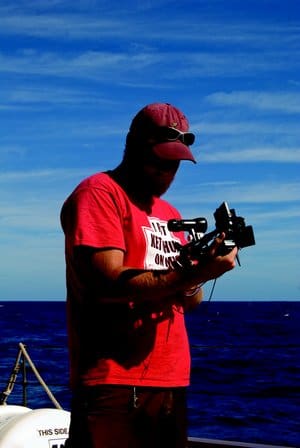The 126-foot knockabout schooner, Virginia, had a rough passage the first week of November from Charleston, S.C., to Bermuda. The seas were boisterous and the remains of Hurricane Ida churned the Atlantic making for tough sledding. It was a wet and windy passage.
By the time Virginia reached Bermuda the weather had abated, promising easier conditions for the 1,000-mile passage that would take the boat to St. Thomas.
Virginia, a replica of a pilot schooner originally built in 1916, was designed and built by Tri-Coastal Marine in Norfolk, Va., and completed in 2005. The boat is rigged as a gaff-schooner, carrying, including the fisherman, seven sails. Virginia has no bowsprit, hence the designation as a “knockabout” schooner. For auxiliary power she is equipped with two diesels. The boat is owned and operated by the Virginia Maritime Heritage Foundation, which uses the vessel for both goodwill and educational programs for the young and not so young.
For the passage south there were six celestial navigation students who would work on their sights while also participating in the running of the boat. The skipper was the calm, competent Stefan Edick, while the first mate was Dylan Clark, a 23-year-old down Easter and graduate of the Maine Maritime Academy. The rest of the crew &mdash 10 in all &mdash were a diverse collection of young, good-humored men and women from all over the country. They worked the boat tirelessly and always with good cheer. In other words, a well-found boat with a good crew!
Virginia departed Bermuda on the 23rd of November, sailing off the dock and by the time the vessel reached Town Cut all the lowers, as well as the two topsails, had been set. Over the next few days the wind refused to settle down and it wasn’t until the 29th that the trade winds began filling in from the northeast. The ship picked them up at about 25° north latitude.
On the morning of Dec. 1, as Virginia approached the islands, Clark, with a degree in small vessel operation and a resume that includes crewing aboard the schooners Bowdoin, Lettie G. Howard and Elissa, got up on deck to shoot some stars &mdash just as he did every morning.
Virginia was reaching and the deck was stable. Clark went to the quarterdeck and braced himself. At nautical twilight he observed Arcturus, Spica and Sirius. The DR at the time of his shots was 20° 08′ N by 64° 28′ W. His height of eye was 16 feet and there was no error on the sextant. The time was in GMT. He took an observation of Arcturus at 09:58:07 and got an Hs of 35° 15.8′. He then took a sight of Spica at 10:00:02 and recorded an Hs of 35° 32.2′. He then sighted Sirius at 10:02:14 with an Hs of 24° 35.0′. When he is done he gets what every celestial navigator dreams of: a perfect pinwheel. Great work Dylan!
We will use H.O. 249 Vol.1 for Selected Stars (Epoch 2005) and the 2009 Nautical Almanac. We will find the LHA Aries, reduce the Hs to Ho and then plot the fix. Dylan got a beauty that morning! This is the kind of sight that we aspire to.
A. What are the Ho and intercepts for the three sights?
B. What is the lat/long of the three-star fix?
Answers
A: Ho for Arcturus is 35° 10.5′. Intercept is 26.5 nm toward.
Ho for Spica is 35° 26.9′. Intercept is 9.1 nm away.
Ho for Sirius is 24° 29′. Intercept is 29 nm away.
B: Three-star fix puts Virginia at 20° 10′ N by 64° 30′ W

